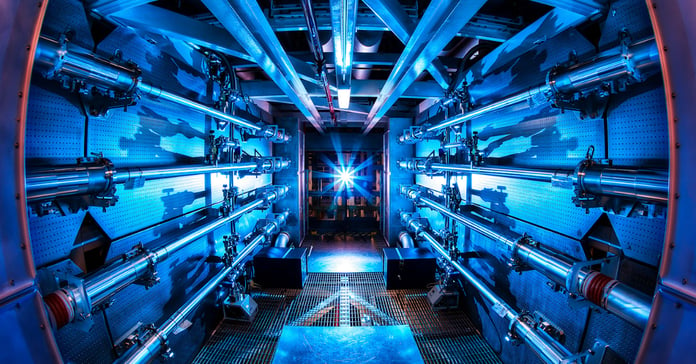
A research team at Lawrence Livermore National Laboratory (LLNL) in California USA has reportedly achieved a net energy gain in Inertial Confinement Fusion (ICF) for the second time on 30 July. This follows on from the landmark success in December 2022, led by Dr Annie Kritcher at LLNL, which reported the first ever ICF net gain.
The continued success of the ICF project is a significant milestone in the path towards the goal of realising commercial fusion energy (arguably the holy grail of limitless clean energy).
But what is nuclear fusion, how does ICF work, and how will this impact both people and businesses?
Nuclear Fusion
At its most simplistic level, nuclear fusion is essentially the process of pushing two atoms or ions so close to each other that their nuclei fuse together to form a new species. The fusion of two nuclei also releases huge amounts of energy, meaning that nuclear fusion is a particularly attractive option as an energy source in the post-carbon world.
The most instantly recognisable source of fusion energy known to us is the Sun (and all the other stars in the sky). Stars are effectively gigantic fusion factories made of searingly hot balls of hydrogen plasma that, being subjected to the huge gravitational forces of the star’s mass over the course of the star’s lifetime, repeatedly fuse to form helium, lithium, and progressively heavier elements until the star eventually dies.
Of course, it is wholly impractical to build a star-sized power plant, and so research teams over the past 70+ years have been researching other mechanisms that could induce fusion. ICF is one of these approaches.
Inertial Confinement Fusion
In essence, ICF seeks to replicate the fusion capabilities of a star in a nanoscale pellet of hydrogen-fuel. At the NIF, 192 laser beams deliver approximately 2 mega-joules of energy to a microscopic pellet of hydrogen fuel over the course of just a handful of nanoseconds.

Preamplifier at the National Ignition Facility (Credit: Lawrence Livermore National Laboratory)
The extreme intensity of this laser radiation instantly vaporises the outer shell of the fuel pellet causing the outer surface to ablate (explode) away from the fuel pellet at extreme speed. In response to this implosion, the inner core of the fuel pellet implodes forcing the ionised hydrogen atoms into contact with each other, and thereby inducing fusion to helium.
Sounds easy enough? Not even slightly
Technically achieving this is like attempting to crush a bar of soap down to a millionth of its size with a pair of chopsticks without dropping the soap. Practically speaking, it’s one of the biggest engineering and scientific hurdles that humanity has ever faced. That’s why LLNL’s success, and now repeated success is so exciting. If LLNL have been able to replicate their original groundbreaking results, then we’re one step closer to being able to realise this in a commercial power plant and provide an almost limitless supply of clean energy.
What’s next?
Nuclear fusion research and commercialisation is already a thriving market across the world with significant innovation being driven forwards in the US, UK, France, Germany, Japan, and China, amongst many others.
With these landmark announcements coming from LLNL, and the magnetic fusion reactor ITER scheduled to come online in Saint Paul-lès-Durance, France in 2025, it is a more exciting time than ever to be involved in the fusion space. As more and more milestones are passed, the commercial reality of nuclear fusion is getting even closer.
Bringing nuclear fusion to mass production will represent an era-defining moment for our global energy requirements, finally breaking our reliance on fossil fuels and ushering in a new age of clean energy. Here at Mewburn, we’re looking forward to seeing the innovation that this drives and working with the teams that are pushing to make true sustainability a reality.
Alex has experience working across all stages of the patent life cycle from invention capture and drafting, through prosecution, to opposition proceedings at the EPO. He is particularly experienced in the fields of optics & photonics and computer-implemented inventions. He also carries out analysis of IP landscapes for freedom to operate (FTO) and IP audit projects, and has experience of helping start-up companies and SMEs build and manage their patent portfolios inventions.
Email: alexander.savin@mewburn.com
Sign up to our newsletter: Forward - news, insights and features
Our people
Our IP specialists work at all stage of the IP life cycle and provide strategic advice about patent, trade mark and registered designs, as well as any IP-related disputes and legal and commercial requirements.
Our peopleContact Us
We have an easily-accessible office in central London, as well as a number of regional offices throughout the UK and an office in Munich, Germany. We’d love to hear from you, so please get in touch.
Get in touch.png?width=100&height=100&name=Alexander%20Savin%20circle%20(1).png)

